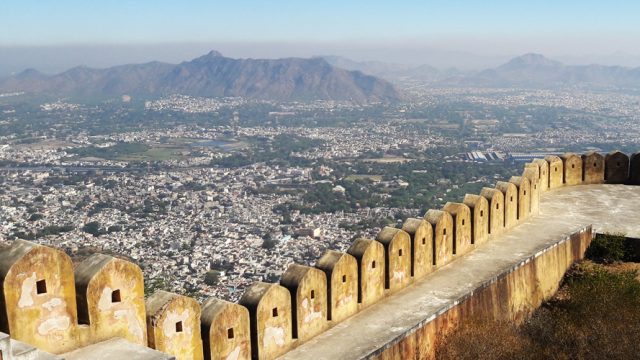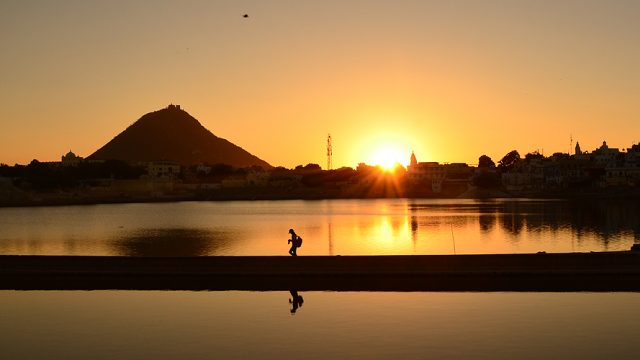Type Religious Festival Time April (In 2016 & 2017) Location Ajmer, Rajasthan It is dusk,
When I return next morning, the crush is as before, as if nobody left the previous night. I can see a row of heads along the far wall of the tomb, in silent communion with the beyond. Behind them is a lone woman, young, thin and quiet. A trickle of tears is flowing down her tired face. An aching, voiceless heart has found a release and a bond.
At first sight, the impression of the Urs is of crowds and more crowds, of a multitudinous humanity that overwhelms you, jostling for space, moving in streams and eddies. You cross a stream, but the sea remains as before. Then, if you surrender yourself to this movement, flow with it, you can sometimes glimpse the story that each heart carries. At every step, I see long letters of appeal and entreaty that the saint’s devotees have tied to his dargah with red threads. It is heartbreaking to read them. “Please let me have my land back, and the shop too. The children are suffering…” reads one.
But it’s not all suffering and craving that throbs in these minds. There’s also joy and bliss that some find in their own faith or in that of the collective, which is the Urs.
Khwaja Garib Nawaz
The Ajmer Urs marks the death anniversary of the revered Sufi saint Hazrat Khwaja (respected master) Moinuddin Chishti – popularly known as Garib Nawaz (helper of the poor) – and is observed every year during the first six days of ‘Rajab’ (the seventh month of the Islamic calendar). Moinuddin Chishti is a giant figure on the Sufi map of the Indian Subcontinent. Sufism itself began as a practice of asceticism in the early history of Islam, imbibed traditions of Christian, Arabic and other popular creeds, and by the 10th century CE, became synonymous with Islamic mysticism, with a great focus on love and adoration of god. As opposed to the hierarchies of mosques and priests, Sufism evolved into a practice of personal communion with Allah. Over centuries, it diversified into five main, not very dissimilar, silsilas (orders). One of them was the Chishti order, to which the Khwaja belonged; indeed, he established this most dominant of Sufi orders in India.
The Khwaja was born Moinuddin Hasan bin Khwaja Gayasuddin Hasan, in the 1130s at Seistan near Khurasan in East Persia, with both his paternal and maternal genealogies said to be traceable to Prophet Mohammed. He became a disciple of Hazrat Khwaja Usman-e-Harooni, of the Chishti silsila, in his youth. After extensive travels in Central Asia, he came to Ajmer in 1191, by divine decree it is said, to spread the faith in Hindustan and settled here for life. Among the first Sufi saints to come to India, he led an illustrious line of Chishti saints in the country, including Nizamuddin Auliya and Salim Chishti.

The Khwaja was deeply revered for his austere life, which spanned almost a hundred years. He ate sparsely, surviving on a dry chappati, wore a simple tunic and distributed all the gifts that the Delhi Sultanate sent his way. The poor identified with him and gave him his most popular appellation, ‘Garib Nawaz’. In 1235, he embraced death in solitude when he withdrew to his cell for six days, asking not to be disturbed. The Dargah Sharif in Ajmer is the place where the saint’s mortal remains lie buried. His tomb at Ajmer slowly became the focus of pilgrims’ devotion as well as Mughal royal patronage. Today, it’s an explosion of architectural styles, traditions, beliefs, customs and people. Devotees believe that the saint’s divine grace lingers on and he intercedes on their behalf to the almighty to answer their prayers. The most famous of these was Emperor Akbar, who walked from Agra to Ajmer over 16 days in January 1570.
The Urs Chronology
The Urs is the Khwaja’s death anniversary; the 2016 Urs was the 804th. Believers have faith that whatever they ask during the Urs will be granted. While this asking involves a great outpouring of personal sorrow and grief, the Urs is also a time of grand celebration and joy. The main street leading to the dargah, the Dargah Bazaar, rever-berates with the beat of drums; thousands of hearts throb in unison. More than 5,00,000 devotees gather to pay homage to the Khwaja on the occasion.



The annual ceremony begins on seeing the moon of Rajab. Four or five days before this, a flag is hoisted over the Buland Darwaza by the Sajjada Nashin (successor representative) of the Chishtis, also called the Diwan. The Khwaja’s tomb shrine is washed twice at night in a ceremony called gusl (bath) and essence of flowers is sprinkled. The tabarruk (blessed food), cooked in one of the remarkably huge degs (cauldrons) near the entrance, is distributed at 3.00am. Throughout the Urs, the famous Jannati Darwaza (the door to paradise), a small door on the western side of the shrine, is kept open. This door is opened only on four occasions in the year – tradition has it that whoever passes through this door will enter paradise.
Pilgrims who come to seek blessings make rich offerings, called nazrana, at the spot where the saint has been entombed. The offerings are rose and jasmine flowers, sandalwood paste, per-fumes, incense and cash. Devotees also bring chadars, votive offerings for the tomb, on their heads and hand them over to the khadims inside the sanctum sanctorum. People tie red threads on the stone jaalis and trees all around the dargah and pray for their wishes to be fulfilled.
The Qul is the grand finale. On the 6th of Rajab, and all through the previous night, the dargah is crammed with devotees, performing rites and prayers, moving with the qawwali beats, reciting the Quran, and just being with the Khwaja and with each other. At 11.00am, the ceremony of the Qul begins, initiated by khadims dressed in their best. The shijara-i-Chishtiya (spiritual lineage of the Chishti order) and verses of petition are recited, and prayers are read. The Diwan arrives from the mehfilkhana to the shrine, the Jannati Darwaza is closed, a cannon is fired from the hill above the dargah and fatiha (mass prayer) is read. Meanwhile, qalandars (a sect of travelling Sufi mendicants) rush into the mehfilkhana where they beat their whips on the ground, shout slogans and make a great noise. Once they stop, the Urs is considered over and pilgrims begin to leave Ajmer.
Music of the Sufis
Zikr and sama (congregational recitation and meditation on the Quran) were part of early Sufism. These practices evolved into recitation of chants and litanies as a stimulus to detachment and forgetfulness from worldly cares. Later, some Sufi traditions, especially of the Chishti silsila, blended sama with Indian classical music and the soul-stirring qawwali was born. During the Urs, qawwali gatherings are held in the mehfilkhana, in the rooms and the gaddis (sitting places) of the khadims in the dargah. In these mehfils, the sitting arrangement and the protocol of giving cash to the qawwals follow the etiquette of the Mughal court. In the mehfilkhana, the Diwan presides, dressed in ceremonial clothes and escorted by torch and mace bearers, seated on a cushion under a tent. The music begins after 10.00pm; the rough but tender voices, the tabla, harmonium, the clapping and swirling devotees carry on into the early hours.
Shopping
The dargah is located at the junction of three bazaars, and during the Urs, these become frenetic fairs. Permanent and temporary shops sell flowers, rose ittar (perfume), glass bangles, prayer mats, textiles, jootis, T-shirts, religious literature and much more. There are also chadars for the dargah and inexpensive CDs of qawwalis.
Where to Stay
Hotel Mansingh Palace (Tel: 0145- 2425702/ 857/ 956, Cell: 09460 132220; Tariff: ₹5,400–9,000), near Ana Sagar Lake, is Ajmer’s finest hotel. Country Inns & Suites (Tel: 6623456, Cell: 08003493024; Tariff: ₹4,000–7,500) on NH8 in Sushant City, offers all modern comforts. Hotel Embassy (Tel: 2425519, 2623859, 2628591, Cell: 09414 005004; Tariff: ₹1,995–3,995), located opposite City Power House, is another good option.
The RTDC Hotel Khadim (Tel: 2627490/ 536; Tariff: ₹1,500–3,000) on Savitri College Road has rooms for all budgets and does not hike up its price during Urs. It is worth opting for Badnor House (Tel: 2627579, Cell: 09829077722; Tariff: ₹3,000), a bed-and-breakfast set in a lovely private house of the Badnor Thakurs. It is next to Hotel Khadim. Hotel Delhi Durbar (Tel: 2633760, 5100760, Cell: 08769785786, 8058 608580; Tariff: ₹700–1,450) is in the Dargah Bazaar near Dargah Sharif. Most of the hotels here offer 6-day packages for the Urs, and the rates are higher than usual.
Where to Eat
The bazaars close to the dargah have a mindboggling spread of dishes, most of which are rich in meat and oil: dal, bhuna gosht, chicken korma and biryani. Further down the Dargah Bazaar, there are stalls offering aloo puri, pakoras, jalebis, dry fruits, dates and sweets.
Honeydew on Station Road offers Continental and Mughlai cuisine. Tandoor Restaurant on Jaipur Road is famous for tandoori specialities. Rasoi in Swamy Complex offers multi-cuisine fare. The popular Hotel Mango Masala on Sardar Patel Marg has an extensive menu comprising north as well as south Indian dishes. Hotel Ambassador’s rooftop restaurant, Ambrosia, has a great ambience and awesome food. Sheesh Mahal, the restaurant at Mansingh Palace, offers meals in a lovely setting overlooking the lake. Silverleaf, at Hotel Embassy, serves good vegetarian food.
Fast Facts
Tourist Office: Rajasthan Tourism Development Corporation, Hotel Khadim, Savitri Girls College Road, Ajmer, Tel: 0145-2627426/ 1364; rajasthantourism.gov.in
Dargah Office Tel: 2429095, 2623948
STD code 0145
Tip Bags and shoes are not allowed inside the dargah. There are makeshift cloakrooms near the main gate during the Urs, and facilities to keep shoes at every gate of the shrine. On the last two days and on any Friday during the Urs, at the time of afternoon prayers, the crowd can be dangerously crushing. The roads to the shrine are blocked to vehicular traffic almost 1km before the dargah
Getting There
Air Nearest airport: Jaipur (135km/ 2.5hrs). Taxis cost ₹1,800–2,500 depending on the vehicle you opt for
Rail Ajmer Junction is well connected to Delhi, Jaipur, Mumbai and Ahmedabad. Local taxis cost ₹180–250 per hour (for an AC car)
Road Ajmer is located on the well-maintained NH8, which connects Delhi to Mumbai via Jaipur and Ahmedabad. Plenty of autos and taxis around town, but be prepared to negotiate fares especially during the Urs Bus Ajmer is served daily by several buses from Jaipur’s Sindhi Camp Bus Terminal. During the Urs, the buses can get extremely crowded
Ajmer Urs
April Festivals
festivals of India





